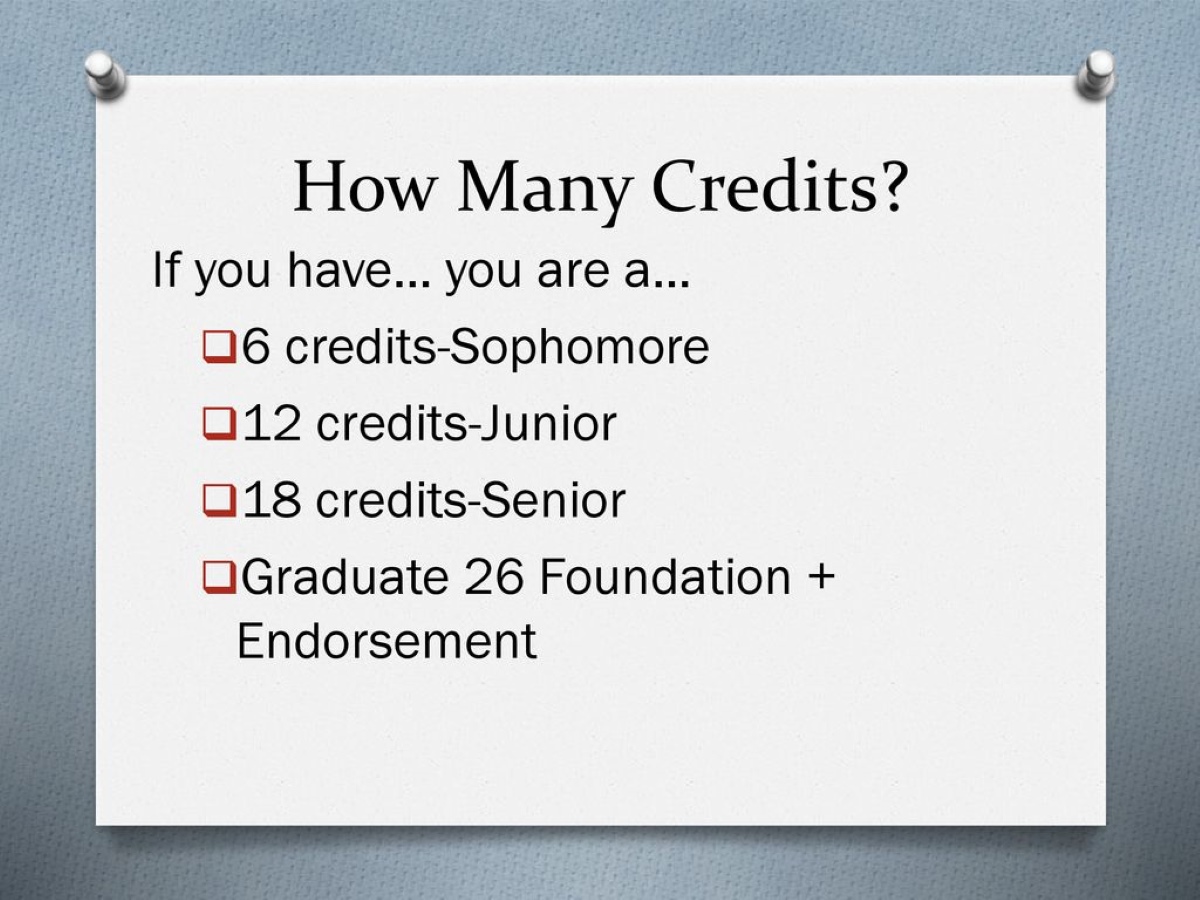

Finance
How Many Credit Hours To Be A Junior
Published: January 11, 2024
Are you wondering how many credit hours are needed to become a junior in finance? Discover the answer and plan your academic journey today.
(Many of the links in this article redirect to a specific reviewed product. Your purchase of these products through affiliate links helps to generate commission for LiveWell, at no extra cost. Learn more)
Table of Contents
Introduction
As students progress through their college journey, the concept of credit hours becomes a crucial factor in determining their academic standing. Credit hours serve as a measure of the time and effort students devote to their coursework. They play a pivotal role in determining when a student can achieve junior standing, a significant milestone in their educational path towards a degree.
Understanding credit hours and their role in achieving junior standing is essential for students to effectively plan their academic schedules and make progress towards their educational goals. In this article, we will delve into the intricacies of credit hours, the requirements for junior standing, and how different programs may have varying credit hour requirements. We will also explore the factors that can influence credit hour progression and provide tips for planning your course load to achieve junior status.
Additionally, we will discuss how the transfer of credit hours can impact attaining junior standing. We will address frequently asked questions to clarify any uncertainties surrounding this topic. By the end, you will have a comprehensive understanding of credit hours, how they contribute to achieving junior standing, and the necessary steps you can take to plan your academic journey successfully.
Understanding Credit Hours
Credit hours are a fundamental component of the higher education system and serve as a quantitative measure of the time and effort required to complete a course. Each course is assigned a specific number of credit hours based on the amount of time students are expected to spend in class and on course-related activities, such as studying and completing assignments.
A typical undergraduate course is usually worth three credit hours, meaning students are expected to spend around three hours in class per week throughout the semester. However, credit hour values can vary depending on the intensity and complexity of the subject matter. For example, laboratory or research-intensive courses may be worth more credits due to the additional time commitment they require.
When calculating the total number of credit hours needed for junior standing, institutions often have specific requirements. These requirements typically entail completing a certain number of credit hours in specific subject areas or meeting specific GPA (Grade Point Average) criteria. However, it is important to note that credit hours alone do not indicate a student’s level of academic achievement; they simply reflect the time and effort spent on coursework.
It is also worth mentioning that credit hours play a role not only in determining a student’s academic standing but also in calculating tuition fees. Most institutions base their tuition charges on the number of credit hours registered for in a semester. Therefore, understanding credit hours and their implications is not only essential for academic planning but also for financial planning during your college years.
As you progress through your college journey, it is crucial to keep track of the credit hours you have completed and the ones you still need to fulfill. This will help ensure you stay on track to achieve your academic goals and meet the requirements for junior standing.
Requirements for Junior Standing
Junior standing is an important milestone in a student’s academic journey. It signifies that the student has successfully completed a certain number of credit hours and has met specific academic criteria set by their institution. While the requirements for junior standing can vary between colleges and universities, certain common elements exist.
Typically, to achieve junior standing, students are required to have completed a specific number of credit hours, usually ranging from 60 to 75 credits. These credit hours include both general education requirements and major-specific courses. In addition to credit hour requirements, institutions often have GPA (Grade Point Average) criteria that students must meet to attain junior standing. These GPA requirements can range from a minimum GPA of 2.0 to a higher threshold, depending on the institution and program.
Depending on the institution, there may also be specific course or subject area requirements that need to be fulfilled for junior standing. These requirements ensure that students have a well-rounded education and have gained a breadth of knowledge across various disciplines.
It is important to consult your institution’s academic catalog or speak with an academic advisor to understand the specific requirements for junior standing at your college or university. They will be able to provide you with the most accurate and up-to-date information regarding credit hour requirements, GPA criteria, and any additional requirements that need to be fulfilled.
Keep in mind that achieving junior standing is not just a marker of progress; it also opens up new opportunities for students. Junior standing often grants students access to more advanced coursework, specialized programs, internships, and other experiential learning opportunities that can enhance their academic and professional development.
By understanding the requirements for junior standing and actively working towards meeting them, you can ensure a smooth transition into your upper-level coursework and maximize your educational experience.
Different Programs and Credit Hour Requirements
While the general concept of credit hours and junior standing applies to all undergraduate programs, the specific credit hour requirements may vary depending on the field of study and the institution. Different programs have different credit hour requirements to ensure that students receive a comprehensive education within their chosen discipline.
For example, majors in the STEM (Science, Technology, Engineering, and Mathematics) fields often require a higher number of credit hours compared to liberal arts or social sciences programs. This is because STEM disciplines typically feature more rigorous coursework, including labs and specialized technical courses that demand additional time commitment.
In contrast, liberal arts or social sciences programs may have a lower credit hour requirement, allowing students to explore a wider range of subject areas and electives.
Furthermore, professional programs such as Nursing, Business, or Engineering may have specific credit hour requirements to meet professional accreditation standards. These programs often integrate internships or clinical experiences, which contribute to the credit hour requirements.
It is crucial for students to be aware of the credit hour requirements for their specific program. Academic advisors can provide guidance on the required courses and the number of credit hours needed to fulfill the program’s requirements.
It is worth noting that while institutions have general guidelines for credit hour requirements, there may be flexibility in course selection within each program. For example, students may have the option to choose from a selection of elective courses to fulfill credit hour requirements, allowing them to tailor their educational experience to their interests and career goals.
When planning your academic journey, consider how credit hour requirements align with your chosen field of study and your personal interests. Strive to find a balance between meeting the credit hour requirements and exploring courses that align with your passion and future goals. This will help you make the most of your college experience and set a strong foundation for your career.
Factors Affecting Credit Hour Progression
Several factors can influence a student’s credit hour progression and their ability to meet the requirements for junior standing. Understanding these factors can help students navigate their academic journey more effectively and make informed decisions about their course load and scheduling.
1. Full-time vs. Part-time Status: One of the primary factors affecting credit hour progression is a student’s enrollment status. Full-time students typically take a higher number of credit hours per semester, allowing them to make faster progress towards meeting the requirements for junior standing. On the other hand, part-time students may take a reduced course load, extending the time it takes to accumulate the necessary credit hours.
2. Course Availability and Scheduling: The availability of courses and their scheduling can impact credit hour progression. Some courses may only be offered in specific semesters or have limited seats. Planning ahead and enrolling in courses early can ensure students have access to the necessary classes and can avoid delays in credit hour accumulation.
3. Academic Support and Resources: The availability of academic support and resources, such as tutoring or study groups, can impact a student’s ability to succeed in their coursework. Students who utilize these resources effectively may be better equipped to handle their classes, leading to successful credit hour completion.
4. Prerequisite Courses: Many degree programs have prerequisite courses that must be completed before advancing to higher-level coursework. Not meeting prerequisite requirements can delay credit hour progression. Students should carefully plan their course sequence to ensure they meet the necessary prerequisites and can smoothly progress through their program.
5. Personal Circumstances: Personal factors, such as work commitments, family responsibilities, or health issues, can also impact credit hour progression. Navigating these challenges may require adjustments to course load or course scheduling to ensure a manageable workload while still making progress towards junior standing.
6. Summer or Winter Sessions: Taking courses during summer or winter sessions can help students accumulate credit hours more quickly. These sessions often have accelerated formats, allowing students to complete courses in a shorter period of time and earn credit hours outside of the regular academic year.
By considering these factors and actively managing their course load and academic planning, students can optimize their credit hour progression, stay on track for junior standing, and successfully navigate their undergraduate education.
Planning Your Course Load for Junior Status
Planning your course load strategically is crucial for making progress towards junior standing. By carefully selecting and scheduling your courses, you can ensure that you meet the credit hour requirements and other criteria necessary to achieve junior status. Here are some tips to help you plan your course load effectively:
- Consult with your advisor: Your academic advisor is a valuable resource when it comes to planning your course load. They can provide guidance on the specific requirements for junior standing in your program and help you create a roadmap for your coursework.
- Review degree requirements: Familiarize yourself with the credit hour requirements for your program. Take note of any specific courses or subject areas that need to be completed. This will help you identify the essential courses you must take each semester.
- Create a long-term plan: Consider creating a long-term plan that outlines the courses you need to take each semester leading up to junior standing. This will help you visualize your progress and ensure you have a balanced course load each semester.
- Diversify your course selection: While meeting credit hour requirements is essential, don’t forget to explore different areas of interest. Take advantage of electives and general education requirements to broaden your knowledge and skills. This will help you develop a well-rounded education and can enhance your future career prospects.
- Consider your workload: Be realistic about your workload and time commitments outside of the classroom. Taking too many credit hours in a single semester can lead to burnout and negatively impact your academic performance. Strike a balance between challenging yourself and maintaining a manageable workload.
- Utilize summer or winter sessions: Taking advantage of summer or winter sessions can help you accumulate credit hours more quickly. Consider enrolling in intensive courses or online classes during these sessions to make progress towards junior standing outside of the regular academic year.
- Stay organized: Keep track of your progress, the courses you have completed, and the ones you still need to take. Utilize tools such as academic planning software or a spreadsheet to stay organized and ensure you are on track to meet the credit hour requirements for junior standing.
Remember that each student’s journey is unique, and what works for one person may not work for another. Be proactive, seek support when needed, and adjust your course load and plan as necessary. By planning your course load strategically, you can set yourself up for success and effectively progress towards achieving junior status.
Transferring Credit Hours and Junior Standing
If you have taken college courses prior to enrolling in your current institution, you may be able to transfer those credit hours toward your degree and potentially accelerate your progress towards achieving junior standing. Transferring credit hours can be a valuable option for students who have completed coursework at another college or university or have earned credits through AP (Advanced Placement) exams, IB (International Baccalaureate) programs, or other recognized exams.
Transferring credit hours involves evaluating the courses you have previously completed and determining their equivalency to courses offered at your current institution. Each college or university has its own transfer credit policies and guidelines, so it’s important to consult with the admissions or transfer credit office to understand how your credits will be evaluated.
When it comes to junior standing, transferring credit hours can positively impact your progress towards this milestone. If your transfer credits satisfy the necessary requirements for junior standing, you may be able to achieve this status sooner than if you were starting from scratch at your current institution.
It’s important to note that while transfer credits may fulfill general education requirements or elective courses, they may not always fulfill specific major requirements. Some programs have limitations on the number of transfer credits that can be applied towards the major, and certain courses may need to be taken at your current institution to fulfill major-specific prerequisites or requirements.
When planning your course load, work closely with your academic advisor to strategize how to apply your transfer credits effectively. They can help you navigate the transfer credit evaluation process and ensure that you make progress towards junior standing while fulfilling all necessary requirements for your chosen major.
Transferring credit hours can be a valuable opportunity to accelerate your academic progress. By taking advantage of this option, you can potentially shorten the time it takes to achieve junior standing and accelerate your journey towards earning your degree.
Frequently Asked Questions
1. Can I achieve junior standing in less than two years?
While it is possible to achieve junior standing in less than two years, it largely depends on the credit hour requirements of your program and the number of credit hours you complete each semester. Some accelerated programs or students with transfer credits may be able to achieve junior standing earlier than the standard two-year timeframe.
2. What happens if I don’t meet the credit hour requirements for junior standing?
If you don’t meet the credit hour requirements for junior standing, you will not be able to advance to the next level of coursework and may not have access to certain upper-level courses or opportunities. It is important to work closely with your academic advisor to map out a plan to fulfill the credit hour requirements for junior standing.
3. Can I take summer or winter courses to fulfill credit hour requirements?
Yes, taking summer or winter courses can be an excellent way to accumulate credit hours and make progress towards junior standing. These sessions often offer intensive or online courses that can help you complete requirements outside of the regular academic year.
4. Can I transfer credit hours from a community college to fulfill the requirements for junior standing?
Yes, many colleges and universities accept transfer credits from community colleges. However, the transfer credit process can vary, and it is essential to consult with your institution’s transfer credit office to understand how your credits will transfer and which requirements they can fulfill.
5. Can I still graduate on time if I don’t achieve junior standing within the expected timeframe?
Not achieving junior standing within the expected timeframe may result in a delay in graduation. However, it is important to remember that every student’s academic journey is unique, and there are often options for making up credit hours or adjusting your course load to get back on track. Work closely with your academic advisor to develop a plan that allows you to graduate on time or make up any necessary coursework.
6. What GPA do I need to achieve junior standing?
GPA requirements for junior standing can vary depending on the institution and program. It is best to consult your institution’s academic catalog or speak with an academic advisor to understand the specific GPA criteria you need to fulfill.
Remember, the answers to these frequently asked questions may vary depending on your college or university. It is always recommended to consult with your institution’s academic advisors or relevant offices for the most accurate and up-to-date information regarding junior standing and credit hour requirements.
Conclusion
Understanding credit hours and the requirements for achieving junior standing is essential for students navigating their college journey. By familiarizing yourself with the credit hour system and the specific criteria for junior standing at your institution, you can strategically plan your course load and make progress towards your educational goals.
Credit hours serve as a measure of the time and effort spent on coursework and play a crucial role in determining the level of academic standing. Junior standing is a significant milestone that opens up new opportunities for students to explore advanced coursework and specialized programs, enhancing their academic and professional development.
When planning your course load, it is important to consult with your academic advisor to ensure you are on track to fulfill the credit hour requirements for junior standing. Course availability, personal circumstances, and the possibility of transferring credit hours should also be taken into consideration when structuring your academic journey.
By strategically planning your course load, diversifying your course selection, and utilizing available resources, you can make progress towards junior standing in a timely manner. Be proactive in understanding your program’s credit hour requirements, staying organized, and seeking guidance when needed.
Remember, everyone’s academic journey is unique, and it is important to stay flexible and adaptable as you navigate through your coursework. Work closely with your academic advisor, take advantage of available resources, and stay focused on your educational goals.
By effectively managing your credit hour progression and successfully achieving junior standing, you will position yourself for a rewarding academic experience and set a solid foundation for your future endeavors.














